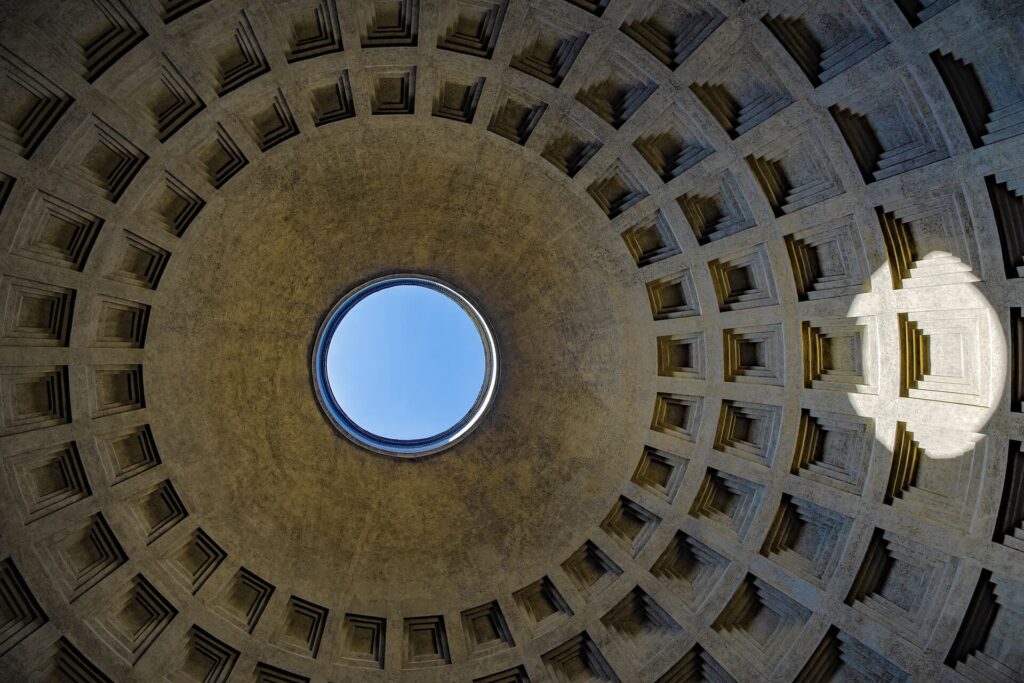Phasellus lectus

Introduction
Mauris ac leo tincidunt nibh tincidunt tempor non quis sem. Sed eget sem augue. Quisque id lorem interdum, convallis massa et, vehicula nunc.
Tools
Supplies
As you walk through the bronze doors of the Pantheon in Rome, your gaze is immediately drawn upwards. Fellow visitors gasp as they marvel at the dome and its Oculus, the circular opening that makes this building particularly unique in the world of architecture.
With a diameter of 43.44 meters, the Pantheon’s dome is one of the most important architectural masterpieces of its time, as well as the largest ever built without reinforced concrete. The fact that it has reached the modern age in such perfect condition, along with the rest of the building, proves just how much skill and architectural genius were present in ancient Rome.
The dome of the Pantheon has two especially unique qualities: it gives an impression of being suspended midair, without any central support to bear the enormous weight of its structure, and even more impressively, the top contains a large circular opening, the oculus.
How was it built?
First, a wooden structure was built inside to support the centring, a curved scaffolding that aided in the construction of the vault. Then it was covered with poured concrete, the main material used for the Pantheon’s dome.
The operation was performed in stages, allowing for the complete solidification of each batch of concrete and guaranteeing maximum stability for the building. Once construction was complete on the lower supporting levels of the dome, the builders proceeded to use progressively lighter layers of concrete.
This can be seen near the oculus where lighter pieces of volcanic debris were used, while closer to the base we can see fragments of brick or tuff, which are heavier and more compact.
This technique, combined with the coffered design, means that the weight of the dome is directed to the sides, making it possible to leave the opening at the top without risking a structural collapse. In the words of Austrian art historian Ernst Gombrich: “There is no sense of weight: the huge dome [of the Pantheon] seems to soar free like a second celestial dome”.
However, this brings up another question. Why was the Pantheon left open? Wouldn’t it have been easier, from an architectural perspective, not to include an oculus?
The simplest explanation is that the opening of the dome, which is 9 meters in diameter, is the only source of light for the whole building. The circular hall doesn’t contain any windows.
However, the main reason behind the oculus is even more fascinating. We shouldn’t forget that the Pantheon was originally built as a pagan temple dedicated to all the gods, including the seven planetary deities, such as the Sun. The shining rays of the Sun god were thus welcomed inside the building, creating a clear link between the inside and the outside, between the Earth and the Heavens.
Furthermore, the beams of sunlight turn the Pantheon into an astronomical observatory.
During the day, you can follow the projection of the sun inside the building, marking the passage of each hour, and even the changing of seasons on certain days of the year. During an equinox or solstice, the Pantheon transforms into a gigantic sundial.

The tombs
During the summer solstice, for example, it is possible to watch as the sun shines through the oculus and projects a luminous circle of exactly 9 meters onto the floor. Another spectacular phenomenon occurs every year on the 21st of April, the anniversary of Rome’s birth, when the sun’s rays illuminate the bronze doors precisely at noon.
The oculus of the dome, however, lets in more than just light. The opening also happens to be an entrance for small birds and rain.
Leaving your umbrella at the entrance to the Pantheon isn’t always a good idea. The rain falls straight into the church, splashing onto the marble floor and making the inside nearly as wet as the outside. Don’t worry about stepping into any large puddles though. The ancient Romans thought of everything, including a system of strategically placed holes to drain away the water.
In addition, the floor itself isn’t completely flat, but instead slightly concave near the holes to facilitate water drainage.
There are numerous legends surrounding the dome’s oculus. One of the most popular claims is that “the hole” at the top of the Pantheon is actually the result of the Devil’s desperate escape from the building when the pagan temple was purified in the Christian era.
The oculus of the dome is undoubtedly the dominant feature that cloaks the building with a mysterious spiritual aura. As you walk around inside the Pantheon and gaze up, you can’t help but feel that you are creating a link with the heavens, just as others have for thousands of years.
If you visit the building during the celebration of Pentecost, fifty days after Easter, that link between Heaven and Earth is transformed into something tangible. During Mass, a cascade of red rose petals floats down from the oculus, symbolizing the Holy Spirit’s descent to Earth.
Whether you are welcomed by a beam of light or by pouring rain, the Pantheon allows you to admire an unparalleled architectural masterpiece, while also making you feel as if you have become part of the history and spirituality of Rome.